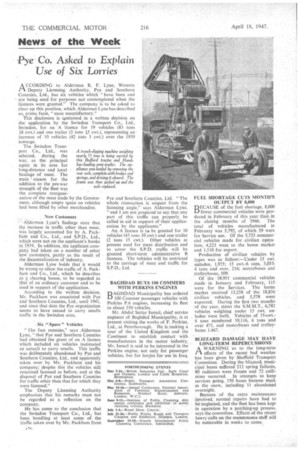News of the Week
Page 28

If you've noticed an error in this article please click here to report it so we can fix it.
Tiye Co. Asked to Explain Use of Six Lorries A CCORDING to Alderman R. F. Lyne, Western ./-1 Deputy Licensing Authority, Pye and Southern Counties, Ltd., has six vehicles which " have been and are being used for purposes not contemplated when the licences were granted." The company is to be asked to clear up this position, which Alderman Lyne has described as, prima facie, "most unsatisfactory."
This disclosure is contained in a written decision on the application by the Swindon Transport Co., Ltd., Swindon, for an A licence for 19 vehicles (83 tons 18 cwt.) and one trader (2 tons 1,5 cwt.), representing an increase of 10 vehicles (42 tons 3 cwt.) over the 1939 tonnage.
The SWindon Transport Co., Ltd., was selected, during the war, as the principal agent in its area for long-distance and local hal:114e of meat. The main ' reason for the addition to the pre-war strength of the fleet was the complete .reorgani-. zation of the meat trade by the Government, although empty space on vehicles had been filled by other merchandise.
New Customers
Aidertnan Lyne's findings state that the increase in traffic other than meat, Was largely accounted for by A_ Pack"barn and Co., Ltd. and S.PID., Ltd., which were not on the applicant's books In addition, the applicant comipany had taken on a number of other new cuftotneri, partly as the result of the 'decentralization of industry.
Alderman Lyne holds that it would be wrong to allow, the traffic of A. Packham and Co., Ltd., which he describes a clearing house, to be regarded as that of an ordinary customer and to be Used in support of the application.
According to the written decision, Mr. Packham was associated with Pye and Southern Counties, Ltd., until 1941, and since that date the Pye organization seems to have ceased to carry smalls traffic in the Swindon area.
Six -"-Spare" Vehicles "The fact remains," says Alderman Lyne, that Pye and Southern Counties had obtained the grant of an A licence Which included, six vehicles (estimated or actual) to carry smalls. This traffic was deliberately abandoned by Pye and Southern Counties, Ltd., and apparently taken over by Mr. Packham and his company; despite this the vehicles still remained licensed as before, and at the disposal of Pye and Southern Counties for traffic other than that for which they were licensed."
The Deputy Licensing Authority emphasizes that his remarks must not be regarded as a. reflection on the company.
He has come to the conclusion that the Swindon Transport Co., Ltd., has been handling at least some of the traffic taken over by Mr. Packham from
Pye and Southern Counties, Ltd. "The whole transaction is suspect from the licensing angle," says Alderman Lyne, "and I am not prepared to say that any part of this traffic can properly be called in aid in support of their applicacat ion by the applicants."
An A licence is ta be granted for 10 vehicles (45 tons 10 cwt.) and one trailer (2 tons 15 cwt.). Other vehicles at present used for meat distribution and to cover the S.P.D. traffic will be granted short-term administrative B licences, The vehicles will be restricted to the carriage of meat and traffic for S.P.D., Ltd.
BAGHDAD BUYS 100 COMMERS WITH PERKINS ENGINES
BAGEIDAD Municipality has ordered 100 Commer passenger vehicles with Perkins P.6 engines, increasing its fleet to about 350 vehicles.
Mr. Abdul Sattar Ismail, chief service engineer of Baghdad Municipality, is at present visiting the works of F. Perkins, Ltd., at Peterborough. He is:making a tour of the United Kingdom and the Continent to establish contact with manufacturers in the motor industry. Mr. Ismail is said to be interested in the Perkins engine, not only for Passenger vehicles, but for lorries for use in Iraq. FUEL SHORTAGE CUTS MONTH'S OUTPUT BY 8,000
BECAUSE of the fuel shortage, 8,000 fewer commercial vehicles were produced in February of this year than in the closing months of 1946. The total of vehicles manufactured in February was 5,792, of which 59 were for Service use. Of the 5,733 commercial vehicles made for civilian operation, 4,223 went to the home market and 1,510 for export.
Production of eivilian vehicles by types was as follow:—Under 15 cwt. unladen, 1,975; 15 cwt.-6 tons. 3,033: 6 tons and over, 216; motorbuses and trolleybuses, 509.
Of the 18,951 commercial vehicles made in January and February, 115 were for the Services. The home market received 13,258 of the 18,836 civilian vehicles, and 5,578 were exported. During the first two months of the year, states the S.M.M.T., 6,782 vehicles weighing under 15 cwt. unladen were built. Vehicles of 15-cwt.6 tons numbered 10,116. 6 tons and over 471, and motorbuses and trolleybuses 1,467.
BUZZARD DAMAGE MAY HAVE
LONG-TERM REPERCUSSIONS A WARNING as to the long-term I-1 effects of the recent bad weather has been given by Sheffield Transport Committee. During the blizzard, municipal buses suffered 212 spring failures, 80 radiators were frozen and 72 collisions occurred. In attempts to keep services going, 150 buses became quek in the snow, including' 11 abandoned overnight.
Because of the extra maintenance involved, normal repairshave had to be neglected, and the fleet has been kept in operation by a patching-up process, says the committee. Effects of the recent heavy calls on the maintenance staff will be noticeable in weeks to come.




















































































